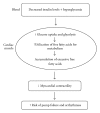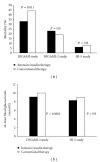Admission hyperglycemia and acute myocardial infarction: outcomes and potential therapies for diabetics and nondiabetics
- PMID: 22830071
- PMCID: PMC3399372
- DOI: 10.1155/2012/704314
Admission hyperglycemia and acute myocardial infarction: outcomes and potential therapies for diabetics and nondiabetics
Abstract
Hyperglycemia, in both diabetic and nondiabetic patients, has a significant negative impact on the morbidity and mortality of patients presenting with an acute myocardial infarction (AMI). Contemporary evidence indicates that persistent hyperglycemia after initial hospital admission continues to exert negative effects on AMI patients. There have been a number of studies demonstrating the benefit of tight glucose control in patients presenting with AMI, but a lack of convincing clinical data has led to loose guidelines and poor implementation of glucose targets for this group of patients. The CREATE-ECLA study, which hypothesized that a fixed high dose of glucose, insulin, and potassium (GIK) would change myocardial substrate utilization from free fatty acids to glucose and therefore protect ischemic myocardium, failed to demonstrate improved clinical outcomes in AMI patients. Studies that specifically investigated intensive insulin therapy, including DIGAMI-2 and HI-5, also failed to improve clinical outcomes such as mortality. There are a number of reasons that these trials may have fallen short, including the inability to reach glucose targets and inadequate power. There is now a need for a large placebo-controlled randomized trial with an adequate sample size and adherence to glucose targets in order to establish the benefit of treating hyperglycemia in patients presenting with AMI.
Figures
Similar articles
-
Glucose-insulin-potassium therapy in patients with ST-segment elevation myocardial infarction.JAMA. 2007 Nov 28;298(20):2399-405. doi: 10.1001/jama.298.20.2399. JAMA. 2007. PMID: 18042917 Clinical Trial.
-
Study design for the Immediate Myocardial Metabolic Enhancement During Initial Assessment and Treatment in Emergency Care (IMMEDIATE) Trial: A double-blind randomized controlled trial of intravenous glucose, insulin, and potassium for acute coronary syndromes in emergency medical services.Am Heart J. 2012 Mar;163(3):315-22. doi: 10.1016/j.ahj.2012.02.002. Am Heart J. 2012. PMID: 22424000 Free PMC article. Clinical Trial.
-
Reduction of hospital mortality rate of acute myocardial infarction with glucose-insulin-potassium infusion.Am Heart J. 1976 Oct;92(4):441-54. doi: 10.1016/s0002-8703(76)80043-9. Am Heart J. 1976. PMID: 785990 Clinical Trial.
-
Acute hyperglycemia in patients with acute myocardial infarction.Circ J. 2012;76(3):563-71. doi: 10.1253/circj.cj-11-1376. Epub 2012 Jan 27. Circ J. 2012. PMID: 22293452 Review.
-
How to best manage glycemia and non-glycemia during the time of acute myocardial infarction.Diabetes Technol Ther. 2012 Jun;14 Suppl 1(Suppl 1):S22-32. doi: 10.1089/dia.2012.0095. Diabetes Technol Ther. 2012. PMID: 22650221 Free PMC article. Review.
Cited by
-
Short and long-term prognosis of admission hyperglycemia in patients with and without diabetes after acute myocardial infarction: a retrospective cohort study.Cardiovasc Diabetol. 2022 Jun 23;21(1):114. doi: 10.1186/s12933-022-01550-4. Cardiovasc Diabetol. 2022. PMID: 35739511 Free PMC article.
-
Stress, Hyperglycemia, and Insulin Resistance Correlate With Neutrophil Activity and Impact Acute Myocardial Infarction Outcomes.Cureus. 2024 Jul 3;16(7):e63731. doi: 10.7759/cureus.63731. eCollection 2024 Jul. Cureus. 2024. PMID: 39100008 Free PMC article.
-
Selective protein kinase C inhibition switches time-dependent glucose cardiotoxicity to cardioprotection.Front Cardiovasc Med. 2022 Sep 7;9:997013. doi: 10.3389/fcvm.2022.997013. eCollection 2022. Front Cardiovasc Med. 2022. PMID: 36158799 Free PMC article.
-
Association of admission hyperglycemia and all-cause mortality in acute myocardial infarction with percutaneous coronary intervention: A dose-response meta-analysis.Front Cardiovasc Med. 2022 Sep 12;9:932716. doi: 10.3389/fcvm.2022.932716. eCollection 2022. Front Cardiovasc Med. 2022. PMID: 36172574 Free PMC article.
-
Race-Ethnic Differences of ST-Elevation Myocardial Infarction: Findings from a New York Health System Registry.Ethn Dis. 2022 Jul 21;32(3):193-202. doi: 10.18865/ed.32.3.193. eCollection 2022 Summer. Ethn Dis. 2022. PMID: 35909638 Free PMC article.
References
-
- Haffner SM, Lehto S, Rönnemaa T, Pyörälä K, Laakso M. Mortality from coronary heart disease in subjects with type 2 diabetes and in nondiabetic subjects with and without prior myocardial infarction. The New England Journal of Medicine. 1998;339(4):229–234. - PubMed
-
- Kannel WB, McGee DL. Diabetes and cardiovascular risk factors: the Framingham study. Circulation. 1979;59(1):8–13. - PubMed
-
- Selvin E, Marinopoulos S, Berkenblit G, et al. Meta-analysis: glycosylated hemoglobin and cardiovascular disease in diabetes mellitus. Annals of Internal Medicine. 2004;141(6):421–431. - PubMed
-
- Shankar A, Klein R, Klein BEK, Moss SE. Association between glycosylated hemoglobin level and cardiovascular and all-cause mortality in type 1 diabetes. American Journal of Epidemiology. 2007;166(4):393–402. - PubMed
-
- Gerstein HC, Riddle MC, Kendall DM, et al. Glycemia treatment strategies in the action to control cardiovascular risk in diabetes (accord) trial. American Journal of Cardiology. 2007;99(12, supplement):S34–S43. - PubMed
LinkOut - more resources
Full Text Sources



